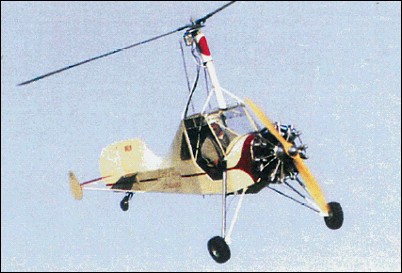Founded in 1995, company is developing a series of autogyros; the original Roto-Pup was to be joined by a new design, the tricycle landing gear, open cockpit Skylark; this is in abeyance while company works on other projects, including a radial-engined aircraft. Workforce one; manufacturing area 55m3.
LITTLE WING ROTO-PUP
TYPE: Single-seat autogyro ultralight kitbuilt; two-seat autogyro ultralight kitbuilt.
PROGRAMME: Initial design work began in 1980 and construction of LW-1 prototype (N45LW), using a Piper PA-11 fuselage, started December 1990; this made its first flight 21 October 1994. LW-2, scaled-down version of LW-1, first flew April 1995; LW-3, controlled by full universal tilting of rotor head, first flew (N46LW) 22 September 1996. Certified by FAA in Experimental category. In 2003, LW-3 was fitted with a seven-cylinder radial engine which has increased empty weight by 45kg; testing continues.
CURRENT VERSIONS:
- Roto-Pup LW-2: Controlled by elevator, rudder and laterally tilting rotor head.
- Roto-Pup LW-3: Controlled by rudder and universally tilting rotor head. Single seat.
- Roto-Pup LW-3+2: Tandem two-seat version. Two flying by end 2000.
(Description applies to LW-3, unless otherwise stated) - Roto-Pup LW-5: Tandem-seat, shorter version. Landing gear moved 24cm forward to compensate for 61cm reduction in length. Flown solo from rear seat.
- Roto-Pup Ultralight: First flew April 1995. McCulloch O-100 engine; fuselage uncovered to remain within 115kg ultralight limit. Controlled by elevator, lateral tilting rotor head and rudder. Offered as plans only.
CUSTOMERS: Four prototypes undertook flight test programme. Total of 130 sets of plans also sold. Two customer kit-built examples have also flown, including one Rotax 914-engined LW-5 which achieved 1,609km cross-country flight in June 2002. Others nearing completion in Belgium, France and Japan, as well as USA.
COSTS: LW-3 kit approximately US$10,000; LW-3+2 US$15,000 (2003).
DESIGN FEATURES: Fuselage design based on Piper PA-11 Cub Special, giving classic autogyro appearance, but scaled-down and using Pratt trusses in place of Cub's Warren trusses. Two-blade Rotor Flight Dynamics rotor; each blade is aluminium bonded and has positive twist. Rotor speed 390 rpm, blade tip speed 140m/s. (Īn LW-2, pitch link to airframe is isolated by elastomeric dampers, determining rotor axis inclination relative to airframe). Rotor mast dampened by large rubber bushes at aft pylon braces. Rotor brake optional, but recommended on all versions.
FLYING CONTROLS: Floor-mounted control stick; cable and pulley actuated elevator in LW-2; LW-3 has no elevators, but floor-mounted control column, pushrods and universally tilting rotor head for pitch and roll, plus cable-actuated rudder. Ground-adjustable horizontal stabiliser for airframe pitch; tip shields at ends of horizontal stabilisers. Push-pull cables used on two-seat versions.
STRUCTURE: Full chromoly 4130 steel tube welded fuselage and rotor pylon; fuselage covered with Dacron fabric and polyurethane finish. Hub structure of 2024-T3 aluminium bar with bolt attachments, pivoted at rotor attachment point for ground adjustment of blade pitch.
LANDING GEAR: Non-retractable type with tailwheel. Mainwheels Hegar 6.50-6 with 1.03 bar tyre pressure. Matco 3.00-2 steerable tailwheel of solid rubber. Internal expanding go-kart style brakes by Leaf. Optional shock-absorbing gear. Floats optional.
POWER PLANT: LW-3: One 52.2kW TEC converted Volkswagen four-stroke engine with dual ignition; options include 2si 52.2kW two-stroke water-cooled engine and various Rotax, Subaru and Hirth engines. Fuel capacity 38 litres in seat tank. Refuelling position on starboard side of cabin. Oil capacity 2.4 litres. LW-3+2: One 82.0kW Hirth F30 or Rotax 912; or 84.6kW Rotax 914 optional power plants in the range 67.1 to 112kW can be fitted. Fuel capacity 49.2 litres. In 2003, company fitted an 82kW Rotec R2800 seven-cylinder radial engine driving a two-blade propeller.
ACCOMMODATION: One or two occupants, according to version, in enclosed cockpit; forward-opening door on starboard side. Baggage compartment behind single seat. Lexan polycarbonate windscreen and side windows.
SYSTEMS: 1,000A 12V battery for ignition back-up and rotor pre-spin. Hydraulic pre-spin optional.
AVIONICS: Micronair 760 nav/com and EIS engine electronic monitoring system are recommended.
Jane's All the World's Aircraft, 2004-2005





